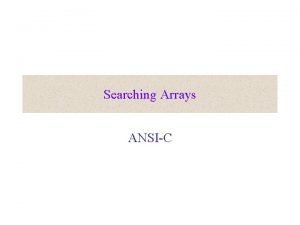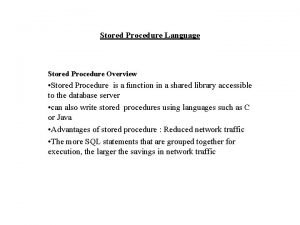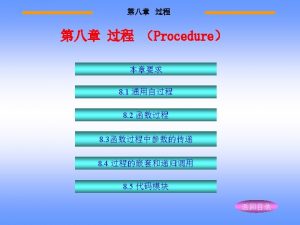Tree Searching Strategies 1 n n The procedure























- Slides: 23

Tree Searching Strategies 1

n n The procedure of solving many problems may be represented by trees. Therefore the solving of these problems becomes a tree searching problem. 2

Satisfiability problem Tree Representation of Eight Assignments. If there are n variables x 1, x 2, …, xn, then there are 2 n possible assignments. 3

Satisfiability problem n An instance: -x 1……. . ……(1) x 1…………. . (2) x 2 v x 5…. …. (3) x 3……. (4) -x 2……. (5) n A Partial Tree to Determine the Satisfiability Problem. We may not need to examine all possible assignments. 4

Hamiltonian circuit problem n E. g. the Hamiltonian circuit problem A Graph Containing a Hamiltonian Circuit 5

n Fig. 6 -8 The Tree Representation of Whether There Exists a Hamiltonian Circuit of the Graph in Fig. 6 -6 6

A tree showing the non-existence of any Hamiltonian circuit. 7

8 -Puzzle Problem Initial State: 2 3 1 8 4 7 6 5 Goal State: 1 2 3 8 4 7 6 5 8

Tree Representation of the solution of 8 -puzzle problem 9

How to expand the tree ? n n Breadth-First Search Depth-First Search Hill Climbing Best-First Search 10

Breadth-First Search Scheme n n In breadth-first search, all the nodes on one level of the tree are examined before the nodes on the next level are examined. It can be accomplished with the help of the queue. 11

Breadth-First Search Scheme n n Step 1: Step 1 Form a one-element queue consisting of the root node. Step 2: Step 2 Test to see if the first element in the queue is a goal node. If it is, stop. Otherwise, go to step 3. Step 3: Step 3 Remove the first element from the queue. Add all descendants of the first element, if any, to the end of the queue one by one. Step 4: Step 4 If the queue is empty, then signal failure. Otherwise, go to Step 2. 12

1 7 2 1 7 8 6 3 4 5 8 6 4 3 4 5 2 1 7 2 8 6 3 4 5 1 1 2 8 6 2 7 3 8 6 5 4 5 1 8 7 2 6 3 4 5 Goal Node 6 3 4 5 1 7 3 2 8 6 3 4 5 7 13

Depth-First Search Scheme n n The depth-first search always selects the deepest node for expansion. It can be accomplished with the help of the stack. 14

Depth-First Search Scheme n n Step 1: Step 1 Form a one-element stack consisting of the root node. Step 2: Step 2 Test to see if the top element in the queue is a goal node. If it is, stop. Otherwise, go to step 3. Step 3: Step 3 Remove the top element from the stack. Add all descendants of the first element, if any, to the top of the stack one by one. Step 4: Step 4 If the stack is empty, then signal failure. Otherwise, go to Step 2. 15

E. G. : the depth-first search n E. g. sum of subset problem Given a set S={7, 5, 1, 2, 10}, answer if S’ S sum of S’ = 9. The Sum of Subset Problem Solved by Depth-First Search. 16

Hill climbing n A variant of depth-first search The method selects the locally optimal node to expand. n E. g. for the 8 -puzzle problem, evaluation function f(n) = w(n), where w(n) is the number of misplaced tiles in node n. 17

Hill Climbing Search Scheme n n Step 1: Step 1 Form a one-element stack consisting of the root node. Step 2: Step 2 Test to see if the top element in the queue is a goal node. If it is, stop. Otherwise, go to step 3. Step 3: Step 3 Remove the top element from the stack. Add the first element’s descendants, if any, to the top of the stack according to order computed by the evaluation function. Step 4: Step 4 If the stack is empty, then signal failure. Otherwise, go to Step 2. 18

An 8 -Puzzle Problem Solved by the Hill Climbing Method 19

Best-first search strategy n n n Combing depth-first search and breadth-first search Selecting the node with the best estimated cost among all nodes. This method has a global view. 20

Best-First Search Scheme n n Step 1: Consturct a heap by using the Step 1 evaluation function. First, form a 1 -element heap consisting of the root node. Step 2: Test to see if the root element in the Step 2 heap is a goal node. If it is, stop; otherwise, go to Step 3: Remove the root element from the Step 3 heap and expand the element, i. e. , add all descendants of the element into the heap. Step 4: If Step 4 the heap is empty, then signal failure. Otherwise, go to Step 2. 21

Goal Node An 8 -Puzzle Problem Solved by the Best-First Search Scheme 22

Q&A 23
 Hình ảnh bộ gõ cơ thể búng tay
Hình ảnh bộ gõ cơ thể búng tay Slidetodoc
Slidetodoc Bổ thể
Bổ thể Tỉ lệ cơ thể trẻ em
Tỉ lệ cơ thể trẻ em Gấu đi như thế nào
Gấu đi như thế nào Glasgow thang điểm
Glasgow thang điểm Bài hát chúa yêu trần thế alleluia
Bài hát chúa yêu trần thế alleluia Các môn thể thao bắt đầu bằng từ đua
Các môn thể thao bắt đầu bằng từ đua Thế nào là hệ số cao nhất
Thế nào là hệ số cao nhất Các châu lục và đại dương trên thế giới
Các châu lục và đại dương trên thế giới Công thức tính độ biến thiên đông lượng
Công thức tính độ biến thiên đông lượng Trời xanh đây là của chúng ta thể thơ
Trời xanh đây là của chúng ta thể thơ Cách giải mật thư tọa độ
Cách giải mật thư tọa độ Làm thế nào để 102-1=99
Làm thế nào để 102-1=99 độ dài liên kết
độ dài liên kết Các châu lục và đại dương trên thế giới
Các châu lục và đại dương trên thế giới Thể thơ truyền thống
Thể thơ truyền thống Quá trình desamine hóa có thể tạo ra
Quá trình desamine hóa có thể tạo ra Một số thể thơ truyền thống
Một số thể thơ truyền thống Cái miệng nó xinh thế
Cái miệng nó xinh thế Vẽ hình chiếu vuông góc của vật thể sau
Vẽ hình chiếu vuông góc của vật thể sau Biện pháp chống mỏi cơ
Biện pháp chống mỏi cơ đặc điểm cơ thể của người tối cổ
đặc điểm cơ thể của người tối cổ Giọng cùng tên là
Giọng cùng tên là













































